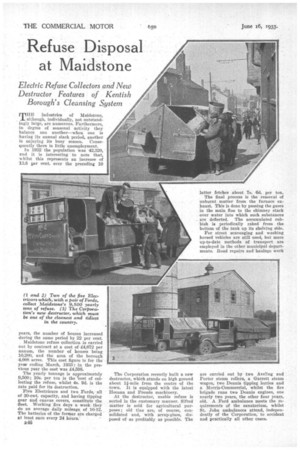Refuse Disposal at Maidstone
Page 64

If you've noticed an error in this article please click here to report it so we can fix it.
Electric Refuse Collectors and New Destructor Features of Kentish Borough's Cleansing System
TEE industries of Maidstone, although, individually, not outstandingly large, are numerous. Furthermore, in degree of seasonal activity they balance one another—when one is -having its annual slack period, another is enjoying its busy • season. Consequently there is little unemployment.
In 1932 the population was '42,320, and it is interesting to note that, whilst this represents an increase of 13.S per cent. over the preceding 10 years, the number of houses increased during the same period by 22 per cent.
Maidstone refuse collection is carried Out by contract at a cost of £4,672 per annum, the number of houses being 10,200, and the area of the borough 4,008 acres. This cost figure is for the year ending March, 1938 ; in the previous year the east was £4,598.
The yearly tonnage is approximately 9,500; 102. per ton is the 'cost of collecting the refuse, whilst 4s. 9d, is the rate paid for its destruction.
Five Electricars and two Fords, all of 30-cwt. capacity, and having tipping gear and canvas covers, constitute the 'fleet. Working five days a week they do an average daily mileage of 10-12. The batteries of the former are charged at least once every 24 hours.
1346 The Corporation recently built a new destructor, which stands on high ground about 1i-mile from the centre of the town. It is equipped with the latest Heenan and Fronde machinery.
At the destructor, usable refuse is sorted in the customary manner. Sifted matter is sold for agricultural purposes; old tins are, of course, consolidated and, with scrap-glass, disposed of as profitably as possible. The are carried out by two Aveling and Porter steam rollers, a Garrett steam wagon, two Dennis tipping lorries and a Morris-Commercial, whilst the fire brigade runs two Dennis engines, one nearly two years, the other four years, old. A Ford ambulance meets the requirements of the sanatorium, whilst St. John ambulances attend, independently of the Corporation, to accident and practically all other cases.






































































































